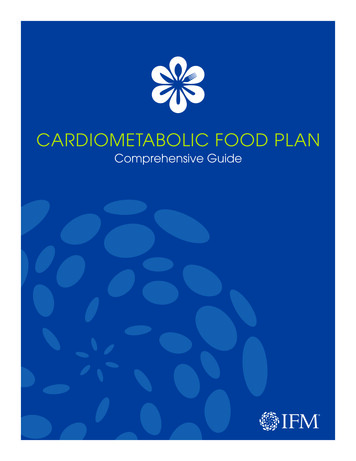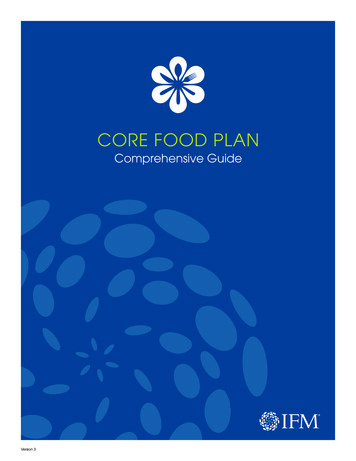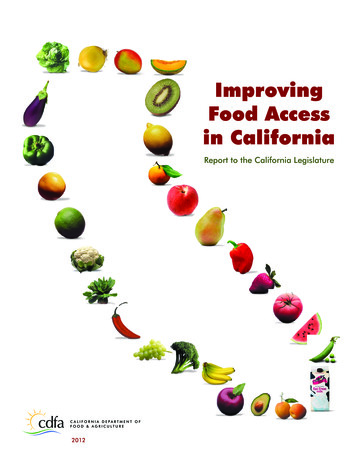
Transcription
CARDIOMETABOLIC FOOD PLANComprehensive Guide
Table of ContentsWhy the CardiometabolicFood Plan?. 3Features of the CardiometabolicFood Plan. 4Touring Through the Food Plan. 11Therapeutic Foods forCardiometabolic Health. 14Condition-Specific TherapeuticConsiderations. 20Frequently Asked Questions. 22Resources and Tools for Success. 24 2014 The Institute for Functional Medicine
Why the Cardiometabolic Food Plan?The Cardiometabolic Food Plan is designed for the following individuals:nThose with risk factors for cardiovascular disease (CVD)nThose with risk factors for dysfunctional metabolic conditions such as metabolic syndrome,type 2 diabetes (T2D), or bothnThose with CVD (e.g., high blood pressure, high cholesterol, and elevated blood fats)nThose with metabolic syndrome (e.g., high blood sugar, increased belly fat)nThose with T2DFortunately, diet and lifestyle interventions are effective in preventing and treating all of these conditions. ThisComprehensive Guide explains what makes this food plan unique for the individual. It also provides answers tocommon questions people may have as they start to follow the plan.Some people may question why the same food plan is suggested to treat both cardiovascular and metabolic diseases.While they may seem to be different types of conditions, cardiovascular and metabolic dysfunctions share similarcauses, including inflammation, insulin resistance, and stress. This food plan is called “cardiometabolic” because itaddresses both disease states. It allows people to use food medicinally to treat the common underlying causes.IFMnCardiometabolic Food Plan Comprehensive Guide 2014 The Institute for Functional Medicine3
Features of the Cardiometabolic Food PlanThis food plan was constructed with the input of a team of physicians and nutrition professionals to enhancetherapeutic effects from eating. Recent evidence from scientific studies is also built into the foundations of the plan.nModified Mediterranean Approach:The traditional Mediterranean diet first attracted interest whenit became apparent that people living on the Greek island ofCrete had a greatly reduced risk of CVD. Since then, it hasbecome perhaps the most well-known, well-studied diet forCVD, metabolic syndrome, and T2D. While the Mediterraneanregion comprises 16 different countries, people in these countriestend to eat a similar diet: whole, unprocessed foods such as fruits,vegetables, whole grains, nuts, legumes, dairy, extra virgin olive oil,spices, modest amounts of poultry, fish and red meat, and red wine.It is not that one of these foods is responsible for the cardiovascularand metabolic benefits of this way of eating, but the combinationof all these foods.A review of 50 studies on the Mediterranean diet reported that this way ofeating favorably changes parameters of metabolic syndrome such as waistcircumference, high-density lipoprotein cholesterol, triglycerides, systolic anddiastolic blood pressure, and glucose.Those who enjoy the cuisine of their own ethnic backgrounds (e.g.,Hispanic, Indian, Chinese, or others) can still choose to include foods fromthe Mediterranean diet in their preferred style of eating. In this Guide, thereis a list of “Therapeutic Foods” that will facilitate such inclusion. For example,people can choose to use extra virgin olive oil in cooking rather than cornor soybean oils, or incorporate tomatoes or a broader array of spices intotheir native cuisine for maximum impact. The key is to select whole, fresh,unprocessed foods rather than to buy pre-packaged foods that have beenmanufactured to be convenient. This is truly one of the most importanttakeaways of the Mediterranean diet!IFMnCardiometabolic Food Plan Comprehensive Guide 2014 The Institute for Functional Medicine4
Features of the Cardiometabolic Food PlannNot all foods have the sameimpact on blood sugar and insulin. Ideally, blood sugar should remain relativelyconstant, without huge spikes that cause insulin to surge in order to shuttle sugarinto tissues that need it, like muscles and liver. A rollercoaster of glucose and insulinlevels throughout the day is not healthy in the long term, especially for those withcardiovascular, metabolic, or diabetic concerns. In fact, high blood sugar levelssustained over time can damage the blood vessels, blood cells, and other parts of thebody that are sensitive to high sugar like the eyes and kidneys. Therefore, regulatingsugar levels by eating foods that do not spike blood sugar is preferred on this foodplan.Low Glycemic Index (GI) and Glycemic Load (GL):There are two ways to assess the impact of food on blood sugar. The first is theglycemic index, or GI, and the other is the glycemic load, or GL. Gl is a wayto measure the impact of a food on glucose levels. Every food with 50 grams ofavailable carbohydrate can be measured for its GI, which is compared against the GIfor glucose (a simple sugar) or white bread, both of which are considered to be highGI, because they lead to increases in blood sugar levels. The goal is to select foodsthat are low in GI so that only small fluctuations are produced in blood glucose andinsulin levels.It is important to recognize that the GI refers to the increase in blood sugar fora defined portion used for all foods. It does not necessarily take into account theportion of these foods eaten in a typical setting. For example, watermelon has ahigh GI, but the average person eats relatively little at a time, so the actual glycemicimpact may not be all that significant.Since we all eat a combination of foods, with differing GI levels, we use the conceptof GL to capture a more comprehensive picture of the glycemic load of the diet asa whole. GL takes into account the quantity of food consumed and is thus a morerealistic measure of glycemic effect.Glucose is calibrated to 100 as the highest GI value; it is optimal to eat foods thathave a GI of 55 or less. Examples of low GI foods include legumes (e.g., soy, kidneybeans, lentils, chickpeas), nuts (e.g., almonds, walnuts), seeds (e.g., pumpkin, flax,sesame), most intact grains (e.g., oat, barley, spelt), and most vegetables and fruits(e.g., peaches, berries).Medium GI foods have a GI of 56-69. While low GI foods are the best choices, itis not unreasonable to anticipate that most people will eat some medium GI foodsperiodically. One tip to remember is that if higher GI foods are eaten, eat themtogether with protein or fat, which blunts the glycemic effect of medium-GI foodsand reduces the glycemic impact of a meal. Examples of medium GI foods includeraisins, most breads and processed grains, many whole-grain choices such as brownor white basmati rice and whole-wheat breads, ice cream, and bananas, to name afew. Most starchy vegetables such as potatoes are also medium GI foods.IFMnCardiometabolic Food Plan Comprehensive Guide 2014 The Institute for Functional Medicine5
Features of the Cardiometabolic Food PlanThe most beneficial whole grains that are low GI with a low or medium GL include steelcut oats, rolled oats, bulgur, and barley. Whole-grain rye bread and crackers with seeds andoats have both a low GI and GL. Other grains and breads are all medium GI and GL.The food plan presented in this Comprehensive Guide provides a list of allowable foodsthat are low or moderate in GI or GL. Eating foods low in GI or portions low in GLhelps to stabilize blood sugar throughout the day. When blood sugar is stabilized, peopleexperience less hunger and cravings and have better health results overall, whether there arecardiovascular concerns, metabolic dysfunction, or blood sugar imbalance.nTargeted Calories: AnThe average meal should provide at least four hours of energy beforethe person feels the need to eat again. Following a meal, one should take note of the energylevel over the next several hours. A balanced meal will result in a feeling of satisfaction,clear-headedness, the ability to focus, and sufficient energy. If the person experiences hungerwithin an hour or so of eating or reports feeling “brain fog,” shaky, or fatigued, it may bethat the meal was missing something, most likely quality protein, fat, or enough whole-foodcarbohydrates to keep the blood sugar levels balanced. These low blood sugar symptoms maybe a response to eating foods with a high GL, or foods that are not tolerated well (hiddenfood sensitivities), or there may be underlying digestive problems. If symptoms continue topersist after following the suggestions in this Comprehensive Guide (and the accompanyinghandouts from a healthcare practitioner), then the next step should be to assess for thepresence of food intolerances and/or digestive dysfunction.IFMqualified health practitioner may prescribe a particular calorie amount.This calorie need is determined by many factors, including current body weight, basalmetabolic rate, activity level, and cardiometabolic risk factor status. A targeted calorie planthat specifies individual food groups and servings can help people lose weight and achievecardiometabolic balance. Many patients prefer more dietary structure to their daily eating togive them guidance and help them achieve balance in their eating choices. It is best to worktogether with a practitioner to determine what is best and suits one’s schedule, bodily needs,and health goals.Regular Eating Times:nCardiometabolic Food Plan Comprehensive Guide 2014 The Institute for Functional Medicine6
Features of the Cardiometabolic Food PlannAlong with the low GI and GL features of this plan, eatingwhole, relatively unprocessed foods also helps the patient take in moredietary fiber and less added sugar. Unfortunately, the average individualliving in a Western country and eating a diet of processed foods gets aboutone-third of the fiber they need each day. Fiber is found in plant-basedfoods like whole grains, nuts, legumes, vegetables, and fruits. It is a formof carbohydrate that the body is unable to digest, giving the sensation offullness without many calories.High in Fiber:There are two types of dietary fiber—insoluble and soluble—and they have somewhatdifferent benefits. Insoluble fiber can be found in the bran (outer coat) of vegetables andwhole grains. This type of fiber acts like a bulky “inner broom,” sweeping out debris fromthe intestine and creating more motility and movement. Soluble fiber attracts water andswells, creating a gel-like mass. The soluble fiber in foods like oat bran, barley, nuts, seeds,beans, lentils, peas, and some fruits and vegetables acts to slow digestion. (Psyllium, themain ingredient of common fiber supplements, is a soluble fiber.) In addition to slowingthe release of glucose from food into the blood (thus warding off the spikes in blood sugarlevels that need to be prevented in cardiometabolic diseases), soluble fiber also traps toxinsand other undesirables (including cholesterol and other dietary fats) in the gut, helping tocarry them to excretion, while also providing “food” for healthy bacteria in the digestivetract. With greater fiber in the diet, a cholesterol-lowering effect may be experienced.Overall, eating more fiber has several benefits, so it is recommended to aim for at least 5grams of fiber per serving of a food, as this is considered an excellent level of fiber.nAnother feature of the Cardiometabolic Food Plan is the reductionor absence of added sugars. Added sugars contribute a significant portion of calories to theAmerican diet (e.g., sugar-sweetened beverages). Eating refined grains and foods withrefined sugar has been positively associated with several CVD risk factors, includingelevated blood fats (triglycerides), low good cholesterol (HDL-C), and decreasedinsulin sensitivity. Refined sugars are prevalent in sodas, fruit drinks, presweetened tea,coffee drinks, energy or sports drinks, and flavored milks.Low in Simple Sugars:It is essential to refrain from added sweeteners as much as possible when followingthis food plan. High-intensity sweeteners can lead to blood sugar imbalances,increased calories and subsequent weight gain, and continued cravings. Half of thebattle against sweeteners can be won by reading food labels. Here is an extensive listof natural and artificial sweeteners that may be found on food labels:IFMnCardiometabolic Food Plan Comprehensive Guide 2014 The Institute for Functional Medicine7
Features of the Cardiometabolic Food PlanAgave nectar, sucrose, fructose, glucose, brown rice syrup, maltitol, mannitol, corn syrup, corn syrupsolids, xylitol, sorbitol, fructose, dextrose, evaporated cane juice, erythritol, NutraSweet, Splenda,aspartame, brown sugar, Demerara sugar, stevia, invert sugar, maltodextrin, maltose, maple syrup,confectioner’s sugar, turbinado sugar, fruit juice concentrate, honey, barley malt, cane sugar, date sugar,caramel.When it comes to satisfying a sweet tooth, one of the best things to do on this plan is tostay close to nature by eating low-GI fruits like apples and unsweetened applesauce, andusing apple juice concentrate for cooking and baking. The least desirable option is to usewhite table sugar and other processed forms of sweeteners. Artificial (synthetic) sweetenersshould be completely avoided as these high-intensity sweeteners may have negative effectson metabolism and could spur food cravings. Artificial sweeteners that should be avoidedinclude aspartame (NutraSweet ), sucralose (Splenda ), acesulfame-K (Ace K, SweetOne, Sunett), and saccharin (Sweet N’ Low ).nDietary fats have had a bad reputation when it comes toheart disease. In the past decades, the popularity of fat-free foods grew exponentially.Unfortunately, what replaced much of the fat in processed products was refinedsugar. This turned out to be a terrible mistake, since added sugar increases blood fatsmore than dietary fat does! Much of the research on the health benefits of dietaryfats has found that what replaces dietary fat matters a great deal. For example, whensaturated fat is replaced with refined carbohydrates, cardiovascular outcomes are notgood. Instead, replacing saturated fats with unsaturated (liquid fats) can lead to an overallimprovement in cardiovascular health.Balanced Quality Fats:Although saturated fats have long been referred to as “unhealthy fats,” especially when itcomes to CVD, not all saturated fats are equal with respect to their effects on the body.Select saturated fats like butter and coconut oil have been included on this food plan asthey are acceptable in small amounts.Despite all the confusion about dietary fats, the message for someone with cardiometabolic issuesis simple: emphasize high-quality oils and fats in the diet and minimize those that are associatedwith disease.IFMnCardiometabolic Food Plan Comprehensive Guide 2014 The Institute for Functional Medicine8
Features of the Cardiometabolic Food PlanEating too much saturated fat (e.g., animal fat, lard) and omega-6 fat (e.g., corn oil,soybean oil) can have “inflammatory” effects. These effects can be offset by adding“anti-inflammatory” fats to the diet. The anti-inflammatory fats are typically high inomega-3 fats compared with omega-6 fats, and include foods like fish, leafy greens,nuts, certain oils, and seeds. Organizations like the American Heart Associationhave recognized the health benefit of these anti-inflammatory oils and encourageindividuals to include more omega-3 sources in the diet. For those with specifichealth concerns such as high blood fats (triglycerides), supplementation with fishoil, an excellent source of omega-3 fats, may be recommended to help bring bloodfats into a normal range.nPlant foods contain thousands ofcompounds that affect body function. While 5,000 to 10,000 of thesecompounds have been identified, it has been suggested that many moreremain unknown. The average person eats only a small amount of suchphytonutrients every day: less than a teaspoon, which is a tiny amountcompared with the many grams of protein, carbohydrate, and fat typicallyeaten, yet even this has dramatic effects in the body. Several of them,such as the bitter compounds in arugula and other green leafy vegetables,the resveratrol in grapes and red wine, and the astringent compounds ingreen tea appear to work favorably on pathways within the cell to createcardiometabolic balance. Certain phytonutrients can intervene to help withblood sugar regulation, lower LDL-cholesterol, and even help to get blood pressureback into a healthier range.Condition-Specific Phytonutrients:Here are some specific phytonutrients in the food plan and how they can help:4-hydroxyisoleucine in fenugreekseeds, charantin from bitter melon, cinnamaldehyde in cinnamon, isoflavones fromsoybeans, beta-glucan from oats and barleyPhytonutrients that assist in blood sugar regulation:Carotenoidsincluding lycopene from tomatoes and red-pink fruit like grapefruit and watermelon,polyphenols like hydroxytyrosol from extra-virgin olive oil, polyphenols from green tea,isoflavones from soybeans, polyphenols from dark chocolate and pomegranatePhytonutrients that assist in the reduction of LDL-cholesterol oxidation:Quercetin from onions,sulfur compounds from garlic, beta-glucan from whole oats, isoflavones from soybeans,polyphenols from pomegranate juice, polyphenols from dark chocolatePhytonutrients that assist in the reduction of blood pressure:IFMnCardiometabolic Food Plan Comprehensive Guide 2014 The Institute for Functional Medicine9
AFOOD PLANNNECTIONTFi bHIgFO RM ATIONCardiometabolic Food Plan Comprehensive GuideinINQ u la n ceda lity Fa tsnAherCOificecSpon- entsConditirinu tPhytoE N E R GYModMedite ifiedrranApproa eanchMEDICINEBaIFMTargetCalo edrieslarguRe TimesgtinEaemiccyGlwandxoeLdInd mic LoaeyclGFEESCAIOMETICLOBURRDFeatures of the Cardiometabolic Food PlaninrsL o w u gale SSi m p 2014 The Institute for Functional Medicine10
Touring Through the Food PlanThe Cardiometabolic Food Plan is designed to give a snapshot of the foods that people should choose from everyday. A health practitioner may provide a set calorie amount and a specific number of selections within the foodcategories. A general description of the food categories below provides a foundation for any calorie-specific plans.Several foods in each category are highlighted as “Therapeutic Foods”; the next section explains why they arepreferable options.VEGETABLES Non-starchyCardiometabolic Food PlanPROTEINSProteinsServings/dayo o o o o o oLean, free-range, grass-fed, organically-grown,meats; non-GMO plant proteins; and wildcaught fish preferredAnimal Proteins:o Cheese, low-fat–1 ozo Cheese, hard–½ ozo Cottage cheese,low-fat–¼ co Egg or 2 eggwhites–1o Egg substitute–⅔ co Feta cheese,low-fat–1 ozo Fish/Shellfish:Halibut, herring,mackerel, salmon,sardines, tuna, etc.–1 ozo 1 Meat: Beef, buffalo,elk, lamb, venison,other wild game–1 ozo Parmesan cheese–2 To Poultry (skinless):Chicken, Cornishhen, turkey–1 ozo Ricotta cheese,low-fat–¼ cPlant Protein:o Burger alternatives:Bean, mushroom,soy, veggie–1 ozo Miso–3 To Tofu, tempeh–½ cProtein Powder:o Check label for #grams scoop–1 protein serving 7 gEgg, hemp, pea, rice,soy, whey1oz serving 35-75 calories, 7g proteinLEGUMESProteins/CarbsServings/dayo o o o o o oo Bean soups–¾ co Black soybeans,cooked–½ co Dried beans, lentils,peas, (cooked)–½ co Edamame (cooked)–½ co Flour, legume–¼ co Green peas(cooked)–½ cServings/dayo Hummus or otherbean dips–⅓ co Refined beans,vegetarian–¼ c1 serving 110 calories, 15g carbs, 7g proteinDAIRY & ALTERNATIVES Proteins/CarbsFatso o o o o o oMinimally refined, cold-pressed, organic,non-GMO preferredbutters –½ TBrazil nuts –2Peanuts –101 serving 45 calories, 5g fatCashews –6Pecan halves –4Chia seeds –1 TPine nuts –1 TPistachios –16Pumpkin seeds–1 TSesame seeds –1 TSoy nuts –2 TSunflower seedkernels–1 TWalnut halves–4o o o o o o oUnsweetenedButtermilk–4 ozozMilk: Cow, goat–4 ozMilk: Almond,coconut, flaxseed,Kefir, plain–4hazelnut, hemp, oat,ozo Yogurt, plain–6 ozo Yogurt, Greek,plain–4 ozsoy–81 serving 50-100 calories, 12g carbs, 7g proteinLow Sugar Impact RecommendationsLimit to 1-2 servings per dayNUTS & SEEDSServings/dayoooooServings/dayo Avocado–2 To Butter–1 t, 2 twhippedo Chocolate, dark,70% or highercocoa–1 sq,1 square 7 go Coconut milk,regular, canned–1½ To Coconut milk, light,canned–3 To Ghee/clarifiedbutter–1 to Mayonnaise,unsweetened–1 tServings/dayooooFATS & OILSProteins/Fatso o o o o o oAlmonds –6oooCoconut, dried flakes, ounsweetened –3 Too Flaxseed, ground –2 T oo Hazelnuts –5oo Hemp seeds –1 Too Mixed nuts –6o Nut and seedo1 serving 45 calories, 4g fato Olives, black orgreen–8o Oils, cooking:Butter, coconut(virgin), grapeseed,olive, (extra virgin)rice bran, sesame–1 to Oils, salad: Almond,avocado, canola,flaxseed, grapeseed,hempseed, high-oleicsafflower, olive (extravirgin), pumpkinseed, rice bran,sesame, sunflower,walnut,–1 tItems in blue indicate preferred therapeutic foods*Nutritional amounts are based on average values for the varietyof foods within each food categoryDietary prescription subject to discretion of health ragusBamboo shootsBok choyBroccoflowerBroccoliBrussels sproutsCabbageCarrotsCauliflowerCeleryChard/Swiss chardChervilChinese cabbageChivesCilantroCucumbersDaikon FennelGarlicGreen beansGreens (beet,collard, dandelion,kale, mustard, turnip)o Herbs/Spices, allo HorseradishCarbso o o o o o oArtichokeoooooJicamaKohlrabiLeeksLettuce, allMicrogreensMushroomsOkraOnionsParsleyPeppers, allRadicchioRadishesSalsaVEGETABLES StarchyServings/dayCarbso o o o o o oo Acorn squash,cubed–1 co Beets, cubed–1 co Butternut squash,cubed–1 co Celeriac cubed–1 co Plantain (½ whole)–⅓co Potato: Purple, red,sweet, yellow–½ mdo Potatoes, mashed–½co Root vegetables:parsnip, rutabaga–½ co Yam–½ md1 serving 80 calories, 15 g carbsLow Sugar Impact RecommendationsShort term: Consider removalLong term: Limit to 1 serving per dayFRUITSCarbso o o o o o oScallionsServings/daySea vegetablesUnsweetened, no sugar addedShallotsoooooooooooooSnap peas/snow peasSpinachSprouts, allSquash (delicata,pumpkin, spaghetti,yellow, zucchini)TomatoTomato juice–¾ cTurnipsVegetable juice–¾ cVegetables,fermentedo Water chestnutso Watercress1 serving ½ c cooked, 1 c raw, 25 calories, 5 g carbs 2014 The Institute for Functional MedicineApple–1 smApplesauce–½ cApricots, fresh–4Banana, med–½Blackberries–¾ cBlueberries–¾ ngo–½ smMelon, all–1 cNectarine–1 smooooooooOrange–1 smPapaya–1 cPeach–1Pear–1 smPersimmon–½Pineapple–¾ cPlums–2 smPomegranateseeds–½ co Raspberries–1 co Strawberries–1¼ co Tangerines–2 smWHOLE GRAINS (100%)Servings/dayCarbso o o o o o oUnsweetenedo Amaranth*(cooked)–¾ co Barley, cooked–⅓ co Bread–1 slo Buckwheat/Kasha*(cooked)–½ co Bulgur (cooked)–½ co Couscous–⅓ co Crackers, rye–4-7o English muffin–½o Kamut (cooked)–½ co Millet* (cooked)– ½ co Muesli–½ co Oats* (cooked;rolled oats, steel-cutoats)–½ co Pasta (cooked)–⅓ co Pita–½o Quinoa* (cooked)–½co Rice*(cooked;basmati, black,brown, purple, red,wild)–⅓ co Semolina (cooked)–⅛co Sorghum*(cooked)–⅛ co Spelt (cooked)–⅓ co Teff* (cooked)–¾ co Tortilla (wheat,teff*)–1, 6 ino Whole wheat cereal(cooked)–½ c1 serving 75-110 calories, 15 g carbs*Gluten freeLow Sugar Impact RecommendationsShort term: Consider removalLong term: Limit to 1-2 servings per dayBEVERAGESo Filtered Watero Green Teao Low SodiumVegetable Juiceo Steamed Soy Milk(organic,unsweetened)o Unsweetened Nut/Seed Milks1 serving 60 calories, 15 g carbsLow Sugar Impact RecommendationsLimit to 2 servings per dayAvoid dried fruit and fruit juices 2014 The Institute for Functional MedicineFats & OilsFats and oils should contribute no more than about one-third of total caloric intake, withless coming from saturated fats. It is advised to refrain from eating trans fats, which aretypically found in highly-processed snack foods like potato chips and baked goods. Noticethe foods in this category that are highlighted as Therapeutic Foods. Eat several servings ofthese foods every week. Keep oils in dark glass containers and throw them out if they smellrancid. Canned coconut milk is included in this category because it is predominantly a fat(not a dairy alternative) when purchased in the can. The boxed variety of coconut milk is adairy alternative because it is lower in fat and contains some carbohydrate. Small, infrequentamounts of coconut oil are acceptable on this food plan.Therapeutic Foods: Avocado, olives (black or green), and extra-virgin olive oil.Nuts & SeedsNuts and seeds provide a variety of options to choose from when a snack is neededthroughout the day. They can also be sprinkled on top of salads, cereals, or vegetables. Tryfor at least 1 to 2 servings of nuts on a daily basis. Aim for a mixed blend of unsalted nutsthat are not roasted in oil. Tahini (sesame seed butter) can be drizzled over vegetables;almond butter can be spread on an apple slice or cashew nut butter on a sliver of pear.Incorporate some of the Therapeutic Foods from the nuts and seeds category every day.Therapeutic Foods: Flaxseed, unsalted mixed nuts, and unsalted soy nuts.IFMnCardiometabolic Food Plan Comprehensive Guide 2014 The Institute for Functional Medicine11
Touring Through the Food PlanProteinProtein stabilizes blood sugar and should be included in every meal. In fact, unlessthere are medical restrictions on dietary protein intake, protein should provide aboutone-third of the daily calories.Yet in the average Western person’s diet, proteincomprises only about one-fifth of the total calories. Choose oily fish high in antiinflammatory fats and low in methylmercury, such as anchovies, herring, mackerel,salmon, sardines, and trout. Other examples of omega-3 fats include free-range eggs(which have about one-quarter of the amount of anti-inflammatory fats found ina serving of fatty fish). It is acceptable for people with CVD to eat eggs on a dailybasis. However, research suggests that it is better for those with T2D to eat less thanone egg per day. The Therapeutic Foods in this category are soy-containing proteinsand fish, which provide anti-inflammatory fats for heart health.Therapeutic Foods: Soy-based foods such as miso, tofu, tempeh, and soy protein, and omega-3 rich fish.Non-Starchy VegetablesThis category of foods provides medicinal compounds that can ward off cardiometabolic disease.Try vegetables not typically eaten aiming for 8 to 12 servings per day.A serving is ½ cup of cooked vegetable or 1 cup of raw, leafy greens. The leafygreen vegetables in this category are Therapeutic Foods because they help correctcardiometabolic disease. Many of these foods found in the Mediterranean diethave been shown to help lower blood pressure by relaxing blood vessels, reducinginflammation, and protecting blood vessels by lessening oxidative stress.To make a juice from these vegetables, use a blender that keeps the fiber andparticulates rather than just squeezing out the sugary juice. If buying pre-madetomato juice, read the ingredient label to make sure it does not contain sugar andis low in sodium.Therapeutic Foods: All greens such as beet, collard, dandelion, kale, mustard, turnip, chard/Swiss chard, andspinach, plus garlic, onions, and tomatoes.LegumesLegumes are a perfect way to get quality protein and complex carbohydrates, both ofwhich will help create a feeling of fullness and help keep blood sugar in a healthy range.It is recommended to eat at least 1 serving of legumes each day in the form of soup,cooked beans, dips, or hummus. Many of the Therapeutic Foods in this category canbe found pre-packaged in the frozen foods section or bought fresh from the producesection.Therapeutic Foods: Edamame (green soybeans), black soybeans.IFMnCardiometabolic Food Plan Comprehensive Guide 2014 The Institute for Functional Medicine12
Touring Through the Food PlanLow-Fat Dairy and AlternativesThe healthcare practitioner will advise the patient whether they should consumenon-fat or low-fat dairy products. Too much animal fat in the diet is not healthy forthe cardiovascular system; however, there are some important types of fats in dairy(e.g., conjugated linoleic acid) that may be protective for the heart. Therefore, it isworthwhile to talk with a qualified healthcare provider about dietary fat intake. Inthis plan, there is no guidance on fat content of dairy products on the food list. TheTherapeutic Foods include soy milk, and probiotic-containing foods to keep the guthealthy.Therapeutic Foods: Soy milk, yogurt, kefir.Starchy VegetablesDepending on recommended calorie intake, consumption of starchy vegetables shouldbe limited to 1 serving per day as they tend to impact blood sugar (they are moderateGI). Only moderate GI starchy vegetables are on this list. High-GI vegetables likewhite potatoes have been left off deliberately as these foods can cause a spike in bloodsugar. Beets are rich in phytonutrients that are heart healthy, thus they are considered aTherapeutic Food.Therapeutic Foods: Beets.FruitsThese low to moderate GI fruits will “hit the spot” when someone is feeling the needfor something sweet. Only 2 servings per day (on a lower calorie plan) are recommended.The Therapeutic Foods in this category contain important phytonutrients that open bloodvessels and help with blood sugar control, so it is recommended that either be one of thetwo choices of fruit each day. It’s always better to couple fruit with a little bit of protein orfat to offset a rise in blood sugar.Therapeutic Foods: Blueberries, pomegranate.GrainsWhole grains—those with an intact bran outer coat—are essential for people withcardiometabolic diseases to eat as they provide an excellent source of fiber and otherphytonutrients that assist with cholesterol reducti
the Mediterranean diet in their preferred style of eating. In this Guide, there is a list of “Therapeutic Foods” that will facilitate such inclusion. For example, people can choose to use extra virgin olive oil in cooking rather than corn or soybean oils,










